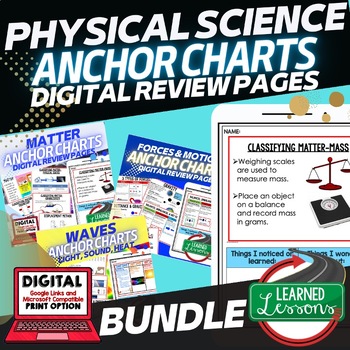Physical Science Anchor Charts BUNDLE (Physical Science Bundle) NGSS Posters
- Zip
- Google Apps™
- Easel Activity

What educators are saying
Products in this Bundle (12)
showing 1-5 of 12 products
Bonus
Also included in
- Physical Science Bundle | Physical Science Full Curriculum | Differentiated Activities | Google Classroom, Print & Digital Distance Learning which covers NGSS Content, Next Generation Science Standards is ALSO PART OF Earth, Life, Physical Science Integrated MEGA BUNDLE- NGSSPHYSICAL SCIENCE BUNPrice $175.00Original Price $512.25Save $337.25
Description
Physical Science 185 Anchor Charts BUNDLE (Great as Bellringers, Word Walls, Study Guides, and Concept Boards) with Google Link for Distance Learning
→ALSO INCLUDED IN PHYSICAL SCIENCE MEGA BUNDLE
These 185 anchor charts are great for representing the topics covered with bright and clear visuals. These could be printed 2 or 4 to a page and students could answer question scavenging through or they could be printed full page in color and laminated to make excellent classroom visuals. Most students are visual learners and benefit from multiple representations of topics.
Topics Represented Include:
-Science Inquiry and Basic Science ANCHOR CHARTS
Scientific Method
Common Laboratory Equipment
Safety Rules
Scientific Theory vs. Law
Metric System
Elements of Life
Characteristics of Living Things
Textbook Tips
-Matter and Its Properties ANCHOR CHARTS
Matter
Classifying Matter
Physical States of Matter
Magnetism
Conductivity
Solubility
Relative Density
Classifying Matter Activity
How We Measure Matter
Mass
Volume
Density
States of Matter –Water
Temperature and Water
Mixtures and Solutions
Mixture Activity
Physical Change
Chemical Change
Physical Properties
Chemical Properties
-Elements, Compounds, and Reactions ANCHOR CHARTS
Atoms
Bohr Model
Electron Cloud
Atomic Number/Atomic Mass
Periodic Table
Chemical Equations
Chemical Reactions and Products
Photosynthesis
Respiration
Law of Conservation of Mass
Rate of Chemical Reactions
Heat and Chemical Reactions
Exothermic and Endothermic Reactions
Combustion
Common Compounds
Elements of Life in Living Organisms
-Forces and Motions ANCHOR CHARTS
3 Types of Forces
Earth’s Forces
Balanced & Unbalanced Forces
New Force
Magnetism
Earth’s Magnetic Field
Gravity
Distance & Gravity
Friction
Newton’s Laws
Object’s Movement Depending on Force
Effects of Force
Measuring Motion and Position
Dependent and Independent Variable
Variable
Constant
Graphing Data Practice
Motion Speed (Time/Distance)
Acceleration
Deceleration
Constant Speed
Velocity
Speed
Acceleration Graph
Velocity Graph
Deceleration Graph
Constant Speed Graph
Time Graph
Average Speed Graph
Constant Speed
Motion Graphs
Changes in Acceleration
-Work, Power, and Efficiency ANCHOR CHARTS
3 Types of Forces
Push and Pull
Balanced and Unbalanced Forces
Net Force
Measuring Motion and Position
Dependent and Independent Variable
Variable
Constant
Testing Forces
Work
Power
Efficiency
Simple Machines
Simple Machines Around You
Work Input
Work Output
Potential and Kinetic Energy
Conservation of Energy
Energy Transformations
-Energy Use and Renewal ANCHOR CHARTS
Fossil Fuels
Energy Transformations
Natural Resources
Renewable Resources
Nonrenewable Resources
Inexhaustible Resources
Energy Consumption
Sustaining Renewable Resources
Technology
Reuse, Reduce, Recycle
Affects of Energy Overuse
Population Growth and Carrying Capacity
Pollution
Air Pollution
Water Pollution
-Properties of Energy
-Types of Energy ANCHOR CHARTS
-Electrical Energy ANCHOR CHARTS
-Sound, Light, and Heat Waves ANCHOR CHARTS
Energy
Mechanical Energy
Electrical Energy
Light Energy
Thermal Energy
Solar Energy
Kinetic and Potential Energy
Energy Transformations
Energy Examples Changing Forms
Natural Resources
Examples of Natural Resources
Renewable Resources
Nonrenewable Resources
Inexhaustible Resources
Energy Origination
Conservation of Energy
Electricity and Energy
Types of Electrical Production
Static
Hydroelectric
Geothermal
Nuclear
Solar
Energy Transformations to Make Electricity
Generators
Wind Turbines
Electrical Flow
Circuits
Open and Closed Circuits
Circuit Parts
Resistance for Electrical Flow
DC/AC Currents
Series and Parallel Circuits
Electrical Measurement (Voltage, Current, Resistance)
Flashlight
Waves
Sound Waves
Light Waves
Heat Waves
Transverse Wave Parts
Transverse Waves
Wave Characteristics
Wavelength and Frequency
Sound Waves
Light Waves
Light Waves Traveling
Reflection
Refraction
Convex and Concave
Electromagnetic Waves
Wavelength of Color
Heat and Energy Flow
FOLLOW TO GET UPDATES WHEN NEW RESOURCES ARE ADDED
Links to all MEGA BUNDLES
- Civics and Government MEGA Bundle
- Economics/Free Enterprise MEGA Bundle
- Civics, Government and Economics/Free Enterprise MEGA Bundle
- American History MEGA Bundle Colonial US to Reconstruction
- American History MEGA Bundle Western Frontier to President Trump
- World Geography MEGA Bundle
- World History Part 1 MEGA Bundle
- World History Part 2 MEGA Bundle
- English MEGA Bundle
- Physical Science MEGA Bundle
- Life Science MEGA Bundle
- Earth Science MEGA Bundle
Other Resources to Check Out:
- Social Studies MEGA BUNDLES
- Deals $2 and Under
- Social Studies Word Walls
- Social Studies Anchor Charts
- Social Studies Picture Puzzles
- Social Studies Games
- Social Studies Cut and Paste
- Social Studies DBQs and Speeches
- Social Studies Timelines
- Social Studies Choice Boards
- Social Studies Graphic Organizers
- SCIENCE MEGA BUNDLES
- Deals $2 and Under
- Science Word Walls
- Science Anchor Charts
- Science Picture Puzzles
- Science Games
- Science Cut and Paste
- Science Guided Notes
- Science I Cans
- Science Choice Boards
- Science Graphic Organizers
CIVICS PAGE
US HISTORY PAGE
GENERAL RESOURCE PAGE
ELA & WRITING PAGE
PHYSICAL SCIENCE PAGE
PHYSICAL SCIENCE RESOURCE PAGE
EARTH SCIENCE PAGE
LIFE SCIENCE PAGE
WORLD HISTORY PAGE
GEOGRAPHY PAGE
LOUISIANA HISTORY PAGE
CLIPART RESOURCE PAGE
learnedlessonstpt@gmail.com
Thank you for your support! --Learned Lessons
Learned Lessons Teaching Material
learnedlessonstpt@gmail.com
#TPTDIGITAL #TPTTECH Google, 1:1, Digital






